Women in the Art Works of Chittaprosad
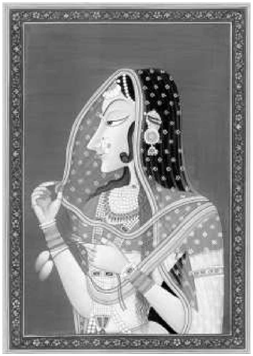
|
Pic 1
|
If we peek into the history of fine arts, women have always been
found at the central focus. The God and Goddess are an important part
of culture, and kings are the things of history, so they are found in
works of art frequently but with a context, but countless images of
unfamiliar women were used to portray them more as a body, that too in
different postures. The case with other countries was the same; the
only difference is the extent of exposure of the body. Whereas in
western countries the image of a nude woman ispresented with
photographic reality, here, in regional art streams like Kangada,
Rajasthani, Mughal,etc., the portraits of
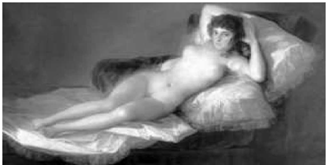
|
Pic 2
|
women are famous for their
distinctive features, being in a flat and two-dimensional image, where,
traditionally, in Indian art, humility and modesty, decency and effort
to cover the body with shyness are the parameters of feminine beauty
rather than the nude image of a woman. (Picture 1 – ‘Kishangarh ki
bani-thhani’) Both are the legacy of a feudal system. To mention here
the portrait made by Goya (1746-1828) (Picture 2) as the artist of the
court to the king of Spain and the portrait (4) made by Hemen Majumdar
(1871-1948) for an Indian king are important. Contextually, the
paintings of Raja Ravi Verma cannot be ignored because they also belong
to the feudal caste. However, it should be noted that though the roots
of these pictures are the same, in spite of similarities, the
distinctions are delineated with splendid excellence. I do not mean to
say that this tendency was found only in the art of the last
century.Let us not discuss the streams which were already doubtful but
we cannot ignore many modern artists with the so-called progressive
artists from the Progressive Artists Group like Ara, Husain, and Souza,
etc. who could not keep themselves free from this complex. Even today,
in modern Indian art the (male) artists do not intend to change
their view in the matter of half of the population of earth but follow
this tradition with full conviction.
Nevertheless, women are the vital, significant and dynamic entity
of society. One cannot imagine a society without women; then how can we
ignore their presence and participation in every important struggle and
decisions. Only Marxist artists understood the importance of their role
in society. They presented her as equal to the man. Accordingly they
depicted woman as essential being in struggle of life and the struggle
for the rights of human beings. In fact, the artists involved in the people’s movements had seen
the continuous and gradual development of this view in society. For
instance, whether it is the Telangana Peasants’ movement or the Tebhaga
movement; the Quit India movement of 1942 or the revolt of Naxalite
peasants, on every front women not only fought shoulder to shoulder
with men to carry the struggle forward but never went on the back foot
at the time of sacrifice.
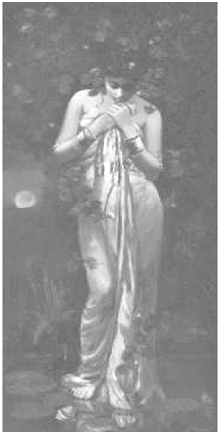
|
Pic 3
|
Undoubtedly, the people’s movements are the
source for developing art for the sake of the common people. That is
why, whenever the strugglefor the liberation of the common people
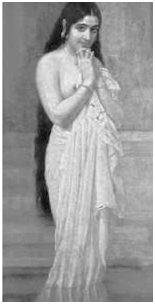
|
Pic 4
|
flares up, this art for the common people is elevated or enhanced with
more influential and evocative strength. Not only the fine arts but the
creation ofother genres such as drama, people’s song (jangeet) and
literature with the lofty face of the common people’s interest could be
possible only in such conditions. After 1936 artists from different
genres turned towards the Marxist ideology and cautiously and
consciously intervened in the changing political circumstances; this
was an unprecedented event in cultural history. During this passage of
time, there were many artists who were not leftists but were
undoubtedly progressive, so the aspects of the common men’s interest in
their works were not less important than in the works of Marxists’
artists. This is the irony of every political organisation of
progressive ideology where the pseudo-progressive artists were many in
number. In fact artists generally belong to such a special class of
educated intellectuals who are normally not associated directly with
oppressed people. They know the formidability of oppression but are far
from the experience of being oppressed. In spite of knowing all the
roads and paths of liberation they confine their responsibility and
commitment towards common people to expressing their opinion about the
basic principles of that movement. In the huge group of Marxist
artists, there were many so-called educated intellectuals who, if they
had an opportunity they would compromise with the system as wellbeing
smart enough to find a reason to justify their association with the
system as well their decision to leave the movement. Undoubtedly, these
artists did great harm to the progressive cultural movement. This deception could be seen very clearly in the founder artists of
Progressive Artists Group in the world of art and painting. The
national and international critics and agents of arts are tangled up to
establish significant artists like Souza as committed to the common
people only to recognise the Marxist and progressive face of his
personality. Even he was projected as though he contributed to the
freedom struggle of India. Undoubtedly, it is true that he came close
to the Indian People’s Theatre Association (IPTA), Calcutta group and
the Communist Party, but he was closer to some foreign and Persian art
collectors than to IPTA and others.
He had laid down an intact plan to set himself up in the art market.
Out of that first in 1946, he took up membership of the Communist Party
and then in 1947, he formed an association with the party’s help that
was consequently recognized as progressive. Then, in 1948, just after
fulfilling their prerogatives, ‘he separated himself’ from the party
for‘seeking free expression (which was impossible with the
party)’.Being an intellectual and educated; Souza had promulgated and
propagated a unique meaning and approach to being progressive, which
was very novel to the market.The Progressive Artists Group, in its
progressive stand, had always campaigned against Neo Indian Painting
(near 1900) and which continued even after independence. But he never
mentioned that Rabindranath Tagore had already established his art
(1931-41) as a strong substitute to the neo Indian art and had proven
his progressiveness in the Calcutta Group by his principles and
behaviour in 1943.
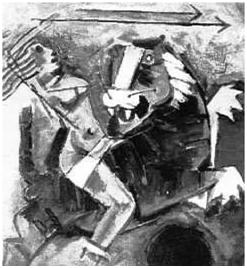
|
Pic 5
|
I have a complaint of the historians: if they
have accepted Souza, Husain, Gade and Ara as progressive, what
adjective would they use for Chittaprosad, Zainul Abedin, Ramkinkar
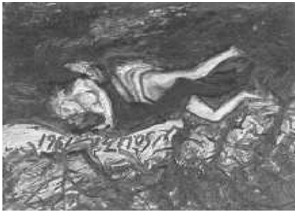
|
Pic 6
|
Baij, Somnath Hore, Quamrul Hassan,etc.Chittaprosad joined the people
and the people’s movement personally and established new parameters and
values of progressive art, but on the other hand Souza insulted women
by portraying them with the temperament of sexual perversity and Husain
painted gods and goddesses because they are the best and most popular
commodity in the Indian art market. Raza entered the world art market
with the wish to trap foreign customers in the web of tantra; in fact
the artists of the Progressive Artists Group were not progressive in
their art or in their commitments. Unfortunately, the system with all
its market interests not only ignored the real progressive artists, but
declared some artists progressive who were not and thereby distorted
the real history. Consequently, true progressive artists have been sent
into oblivion.
All other common people’s
artists like
Chittaprosad, Zainul Abedin, etc. discarded the feudal and narrow
values of the tradition of Indian art works and established the life and
struggles of common men at the centre of their paintings,and they
delineated women in a completely new incarnation. In Somnath Hore’s
paintings, women are harvesting with farmer fighters in the fields,
confronting the landlords with lathis, and participating in
processions. We know about the Santhal women in the paintings of Ram
Kinkar;they are full of energy and enthusiasm going to their work all
alone. Similarly, like men,the women of Chittaprosad are competent
components of society. He also introduced their militant faces in his
sketches. He recognised the woman as a mother in his portraits, who
contributed more than man in producing the next generation.
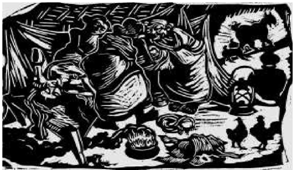
|
Pic 7
|
Women
are at the nucleus in the innumerable paintings of Chittaprosad, but
the assignment of women’s class status is absolutely clear in his art
works. They are represented
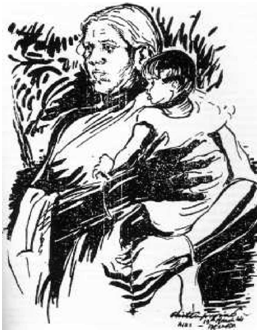
|
Pic 8
|
either as a wife of a farmer or a partner
in labour or a mother of a child labourer or an independent woman who
is cutting rocks or stones. Unlike Husain, there is no apple- polishing
or sycophancy in portraying a woman as a tyrannical and oppressive
woman prime minister of the emergency as the goddess Durga, nor, does
he discover progressiveness in creating commotion in the market by
insulting woman, painting her as a means of sexual orgies, as Souza
does. Is this progressive? Chittaprosad is so different that he can
never be analysed and evaluated by the elite art critics fostered by
the government and rich with their lame language. How can they analyse
him if they are completely ignorant of that class which is depicted in
Chittaprosad’s works of art?
Chittaprosad depicted women as performing their important roles,
not as a commodity to entertain man. They are either in labour or
giving birth to a child (7). Only a committed artist like Chittaprosad
can create that scene. It was the height of his commitment towards the
oppressed class and his imagination which made it an invaluable piece
of art. Like most of his black-and-white pictures as in this lino cut
picture, we can see the rhythmic lines. According to the demands of an
event, the birth of a child is restricted to the dark corner of the
room, and three women are busy performing their duty to bring the child
into this world. The only lantern is fighting with the darkness of the
room. The description of the atmosphere inside and outside is
delineated meticulously. In the history of Indian art, such a
meticulous description of reality has been found only in the sixteenth-
century Mughal art of Basawan, in the portraits of the artists in the
court of Akbar. These paintings are not like photographs, where we
simply find superficial presentations of reality, but are significant
for their creativity and imagination.
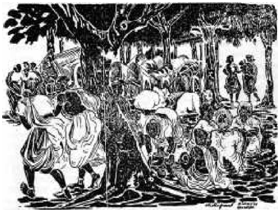
|
Pic 9
|
The All India Kisan Sabha’s Vijaywada Conference was
important to the Communist Party for many reasons. In this conference,
the photographs of Sunil Janah and Chittaprosad’s black- and-white
portraitures based on the famine in Bengal were exhibited. The then
general secretary P.C. Joshi wrote a long article, ‘The Pen Portrait of
the Vijaywada Conference in the Midst of Patriotic Peasants’ in the
‘People’s War’ issue 9 April, 1944. Chittaprosad also attended the conference and made many portraits at
this conference, which are published with the article of P.C. Joshi. He
especially painted the women participants in the conference. From this
series, there is a picture of an Andhra woman with a child in her lap
(8) who participated in the conference. At the very outset, it seems
highly simple in its content and form, but the main attention should be
given to the fact that earlier, peasant women never had any position in
the history of Indian art. This fact provokes a question whether any
other famous artists had attended such conferences?
Apart from different sessions, he painted some extraordinary pictures
of women participants involved in gossiping, understanding the
well-being of each other, in one sketch
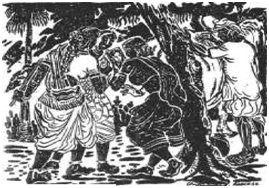
|
Pic 10
|
(9),some peasants were taking
rest in a mango orchard; oxen were untied from the cart and were
chewing the cud. The pleasure of attending the conference can be
understood easily in seeing two women, one of them with a child on her
lap, at the right side of the picture. They are lost in discussion of
their pleasures and pains. This picture looks like a gathering of
villagers at a fair rather than a political party’s conference.
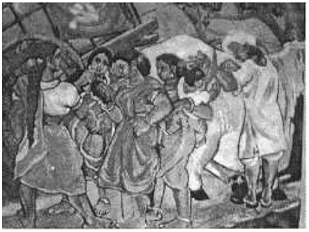
|
Pic 11
|
In another picture which is more or less similar to this picture, (10)
women participants of a conference are looking at a portrait with
enthusiasm. It is a portrait of the martyr Zoya Kosmodemyanskaya
(1923-1941), who was in the front rank of a Soviet armed confrontation
against a fascist attack. Zoya was caught in the field by the German
army and became a prey of the atrocities of the German army officers,
and finally she was hanged to die.
The majority of Chittaprosad’s works are either created with black ink
and brush/ pen or are carved in wood or lino cut. Besides these, there
are many pictures made with water colours, pastels, and oil colours on
paper and on canvas. In a painting of women and the peasant movement
we find a group of people who came to the city from the village by
bullock-cart to participate in a political demonstration in Mumbai,
where the mother with her suckling is most important because it
demarcated her political commitment.
<>Women in Chittaprosad’s portraitswork shoulder to shoulder with men
and are not physically weak. He respectfully delineated their laborious
fa es ripening in the
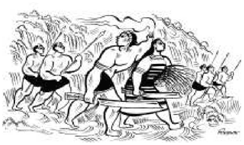
|
Pic 12
|
<>struggle of life. In a significant painting,
Chittaprosad painted the farmers of the Garo mountains. This was first
published with the prose work of people’s poet Subhash Mukhopadhyay. In
the Garo Mountains the wild boars are a great challenge to crops in the
fields. In the painting, the group of farmers is furnished with swords
and spears, and is going to hunt wild boars. In this picture, a woman
with weapons, like the men, is also going to save the crop from the
wild boars. Similarly, in another picture (13) a woman sharing the work
with her fellow men is wearing a patched sari; in another picture (14)
he illustrated a group of labour where, without any discrimination, men
and women are working
<>
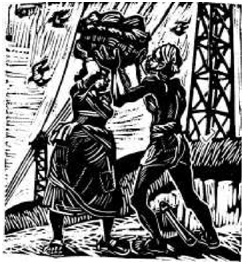
|
Pic 13
|
<>Apart from the pictures depicting women in the role of sharing
labour with men, he portrayed many where only women, either singly or
in a group, are labouring or struggling; one of them is a unique
depiction of a group labour of women pushing a truck full of stones to
bring it across the ascending slope of the mountain.
There are some lino cuts (16 & 17) of labourer women by
Chittaprosad where he depicted extraordinary women doing ordinary jobs.
In the first linocut, three Christian women are going to the market to
sell chickens, on the way they sit to take a breather and are talking
to each other intimately. It is a black-and-white picture, but its
texture is noteworthy because the black complexion of the women and
their bright dresses make the mood of the picture colourful. In another
picture, he sketched a mother building a road with her small child tied
on her back, and she has come upon a woman selling fruit on the road
side with her two children; one on her lap and the other a girl sitting
beside her. This picture clearly shows the sympathetic and sensitive
approach of the artist.
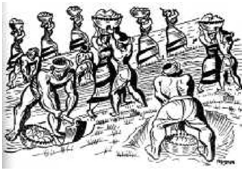
|
Pic 14
|
This woodcut (18) is important for the texture where he illustrated Marathi
women going back home from their job by tram. (This picture belongs to
that time when the trams ran in Mumbai.) In the tram, the conductor is
the only man; all the rest are women talking to each other.
By incorporating mothers in his art, Chittaprosad has paid
tribute to those mothers who are neglected in our art and society
because they belong to the lower class due to their financial and
social status. There is a linocut (19) of a Marathi woman with a child
in her lap created in 1956, and similarly in another portrait, there is
a mother with her two children. In this remarkable but natural picture,
the eyes of the mother and children draw one’s attention and unexpectedly they recall the style of Jamini Roy.
Besides all this art work, there are some memorable paintings on
serious issues. In 1948, the army of the Nizam of Hyderabad, his
goondas and the army of independent India carried out outrageous
atrocities on the revolutionary poor farmers of Telangana. Peasants
were killed in large numbers, their houses were burnt and their women
were raped. This brutality is depicted with sensitivity in the poetic
work ‘Udyini’ written by Ganginini.
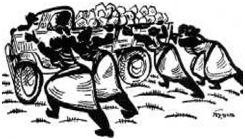
|
Pic 15
|
Chittaprosad made a sketch for this poetic work with his dark ink
pen (21). The subtle description of that shocking incident keeps it
alive in the memory of viewers. Even in today’s India these kinds of
fierce atrocities are continued. Therefore, this picture of
Chittaprosad shows a black history which, unfortunately, is relevant
even today.
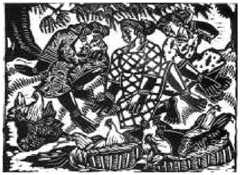
|
Pic 16
|
On May Day 1947, he made a portrait of Mother India (22) which
illustrated the entire history of the freedom struggle in which a woman
with her child in her lap had passed through the
massacre of Jallianwala Bagh, the oppression by the English during the
Quit India movement and the destruction in the Bengal famine and now
she is standing at the start of freedom where the English are ready to
go back to their country with their baggage. This was a significant
moment in Indian history, which was realised
and depicted in real perspective. When we see this picture, it must not
be forgotten that at the time of the transfer of power, the
people’s artists played a prominent role. However, the irony of is this
is that in 1947 some ambitious and selfish artists had made a
thoughtful conspiracy with art traders to present ‘progressiveness’ as
a brand and constituted the ‘Progressive Artist Group’. Because of this
forged act, a large group of common people’s artists were lost in
oblivion.
After six
decades of independence, art work has become just the intellectual
debauchery of rich people of the metropolises. Most of the artists
believe that Indian art is the art of metropolitan cities, and this is
gradually diminishing the interest of the common men in art work. The
attempt to divide art work in two parts is still in progress. One is
the higher art of the rich class and the other is the popular art of
the lower class, which is unscientific as well as dangerous to society.
Today, to understand the art work of Chittaprosad is much more
indispensable than in the past. The process of dividing society into
states, regions, metros, tribal areas, on the basis of language,
culture, economic and sociological basis has become a dangerous
compulsion for the present ruling system. Chittaprosad picturised such
labouring classes, which are integrated
with each other due to the affinity in their problems, oppression and
struggles. Therefore, the responsibility of conception and perception
of the concept and assessment of Indian art cannot be given to art
traders, government academies and self-esteemed art critics. Certainly,
‘contemporary’ Indian art is an incomplete and
unscientific concept which can be developed in the right direction by
the intervention of people-oriented artists.
Translated from the Hindi by Archana.
Source: Ashok Bhowmick, ’Takat Adhi Duniya Ki’, Madhya Pradesh Pragatisheel Lekhak Sangh, Indore, 2012, pp. 15-33.
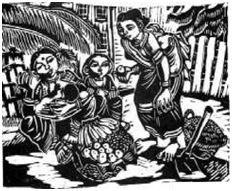
|
Pic 17
|
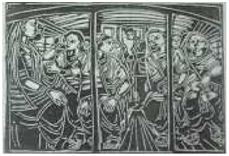
|
Pic 18
|
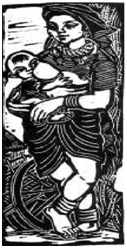
|
Pic 19
|
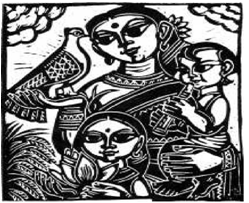
|
Pic 20
|
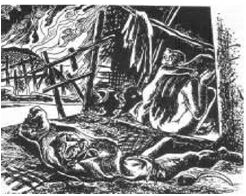
|
Pic 21
|
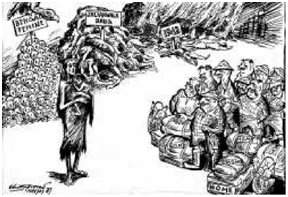
|
Pic 22
|
Click here to return to the April 2016 index.






















